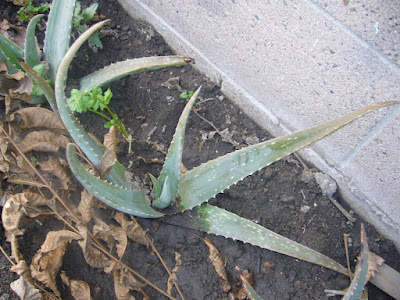Friday, March 13, 2009
Friday, February 6, 2009
Family Caricaceae
Family Anacardiaceae
 One species of the Anacardiaceae family was identified in only one of the 101 lots surveyed.
One species of the Anacardiaceae family was identified in only one of the 101 lots surveyed.1. Mango - Magnifera indica
Comments: An unexpected finding was that of a mango seedling that is at least one year old, informed its "Jaliscience" owner in lot # 120. He is growing the mango not for himself but for a neighbor of the farm. Mangos are usually eaten raw in the farmers home country of Mexico, he said. The skin is removed, lemon juice and chili powder is added for taste!
Sunday, February 1, 2009
Family Apiaceae
 Three cultivar species of the Apiaceae family were found, all are regularly used in Mexican cuisine.
Three cultivar species of the Apiaceae family were found, all are regularly used in Mexican cuisine.1. Cilantro (corainder, top) - Coriadrum sativum
Comments: Self-seeding annual, strong tangy flavor. Center to Mexican cuisine. Two of the growers import their seed from Mexico, while others leave a few plants for seeds or buy the seeds at nurseries, share or trade their seeds with other farmers. Suprisingly, the cilantro at the farm is much thicker in texture than grocery varieties. Found in 45 lots.
2. Zanahoria (carrots, bottom) - Daucus carota subsp. sativus
Comments: Plant that often fell "victim" to topos or moles when the farm was first established. Farmers buy seeds at local nursery. Found in 7 lots.
3. Apio (celery, not shown) - Apium graveolens
Comments: Primarily used in caldos or soups. Farmers buy seeds.
Friday, January 30, 2009
Family Cucurbitaceae

Two species from the Cucurbitaceae family were identified.
1. Cucurbita ficifolia Bouche - chilacayote, Malabard gourd
a. pinto or spotted (top) identified in 2 lots (#82, #3)
b. blanco or white (middle) identified in 1 lot (#144)
Comments: Annual, tendrilled vine. Both varieties are used to make crystallized candy. Fruit is placed in a mixture of lime and water for 24 hours to soften the hard skin before cooking. All three farmers are from Mexico.
2. Sechoum edule subsp. edule (Jacq.) Sw. - chayote or pear-vegetable (bottom).
Comments: Annual, tendrilled vine. This domesticated variety was found in 5 lots (#3, #80, #82, #141, and #153). The skin is removed, the fruit is pitted and then steamed, used in soups or sauteed with other vegetables.
 |
| From Stanford/Avalon Farm Research |
Subscribe to:
Comments (Atom)



















